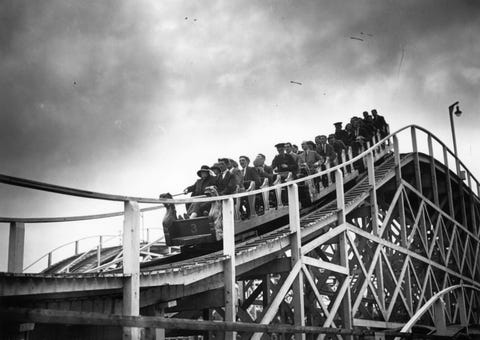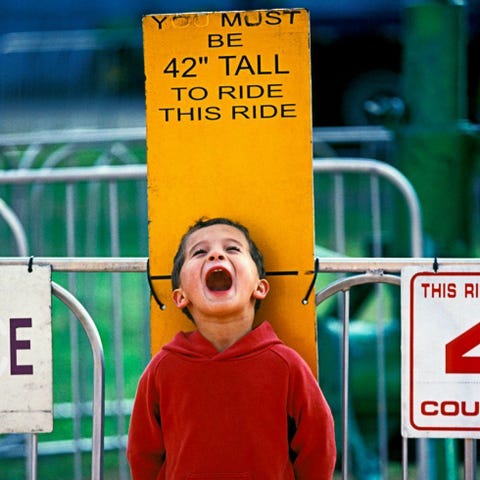Interactive Roller Coaster Design Games
1. If all countries were as cold as Russia, roller coasters may not exist.
In the 17th century, the Russians froze water over a 70-foot-tall wooden structure to make an ice ramp. Riders would sit on blocks of wood and ice stuffed with straw and, with a slight push, slide down. Paris wanted in on the fun, but soon realized that the whole idea falls apart in France's warmer climate. So they added wheels onto the sleds and a track to the ride in 1817, effectively creating the modern roller coaster.
2. The world's fastest roller coaster is very fast.
This content is imported from YouTube. You may be able to find the same content in another format, or you may be able to find more information, at their web site.
Formula Rossa at Ferrari World Abu Dhabi in the United Arab Emirates reaches freak out–worthy speeds of 149 mph in under five seconds. If you don't want to travel abroad for a similar thrill, the U.S. is home to six of the 10 world's fastest roller coasters.
3. The U.S.'s first roller coaster was very slow.
Called the Switchback Railway, the New York attraction opened in June 1884 in Coney Island, Brooklyn—and reached a whopping speed of 6 mph (hey, what do you want for a nickel?). While it's laughable compared to today's coasters, it grossed an average of $600/day—about $15,000 nowadays! Plus, it sparked the country's obsession with amusement park rides.

Getty Images
4. There's a roller coaster still in use that's over 100 years old.
This content is imported from YouTube. You may be able to find the same content in another format, or you may be able to find more information, at their web site.
The world's oldest roller coaster, Leap-The-Dips in Altoona, PA, was built in 1901. It was almost destroyed when it shut down in 1985, but 11 years later it was named a National Historic Landmark and restored to working order three years after that.
5. Height restrictions exist for good reason.
"During normal operation, physics will hold someone in their seat on almost all roller coasters," says Robert Niles, editor of ThemeParkInsider.com. Though roller coasters run smoothly most of the time, emergencies cause operators to hit the safety break. "The restraints are there in case of a sudden stop," Niles says. But the restraints may not protect someone who doesn't meet the height requirement. Might not want to turn a blind eye when you catch your kid standing on tiptoes.

Getty Images
6. During busy season, rides at major theme parks may be tested at least three times a day.
Engineers often harness themselves to different areas of the ride to check for loose bolts, rust, oil and anything that could potentially stop things from operating smoothly. To simulate passengers, they even strap sandbags into the seats and send them around the track at full speed.
7. Most roller coasters don't have engines.
They move by converting potential energy (what they have when they're sitting on top of the track) into kinetic energy (the kind they have once gravity makes the cars fall). As the cars go back up, the kinetic energy converts back to potential to keep the ride moving. "Imagine riding your bike," says Ted Bunn, chair of the physics department at the University of Richmond in Virginia. "If you coast down the hill, you can use the energy you gained from that to coast back uphill, at least for a while. It's the same thing."
8. A group of guys went on 74 roller coasters in 24 hours.
They broke the world record. In a single day, Philip A. Guarno, Adam Spivak, John R. Kirkwood and Aaron Monroe Rye went to 10 parks in four U.S. states, traveling by helicopter between them. They did it to raise $40,000 for the Children's Miracle Network.
9. You're more likely to die tumbling off your bed than get seriously hurt on a roller coaster.
Roller coasters are scary—that's the point! But aside from the random incident here or there (do NOT Google them), they aren't actually dangerous compared to other daily activities. According to the National Safety Council, you've got a 1 in 24 million chance of getting seriously injured on an amusement park ride. You have a greater shot of dying by falling out of bed in the morning (a 1 in 423,548 chance, in case you were wondering).
This content is imported from Third party. You may be able to find the same content in another format, or you may be able to find more information, at their web site.
10. One of the most famous roller coaster engineers had intense motion sickness.
His name was Ron Toomer, and despite being known as the king of steel roller coaster design, he wouldn't go on the more than 80 rides he designed for amusement parks like Six Flags, Busch Gardens, Knott's Berry Farm and Cedar Point. He's famous for saying that he's ridden enough roller coasters to know what happens.
This content is created and maintained by a third party, and imported onto this page to help users provide their email addresses. You may be able to find more information about this and similar content at piano.io
Interactive Roller Coaster Design Games
Source: https://www.womansday.com/life/travel-tips/a51303/10-things-you-never-knew-about-roller-coasters/
Posted by: smithnalled.blogspot.com

0 Response to "Interactive Roller Coaster Design Games"
Post a Comment